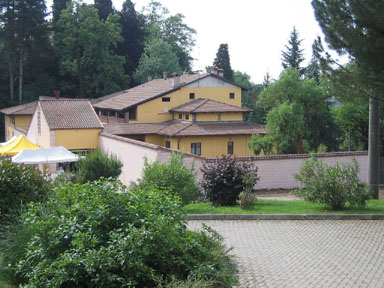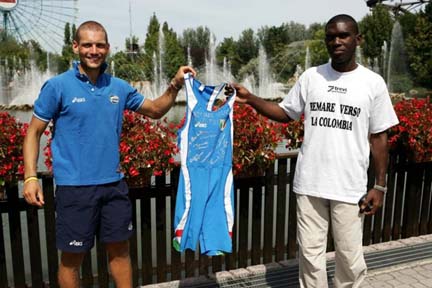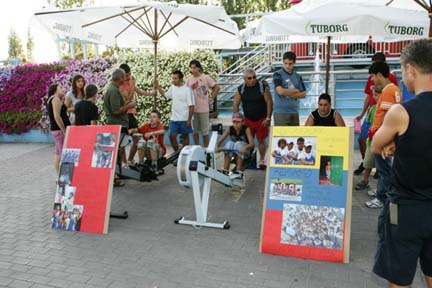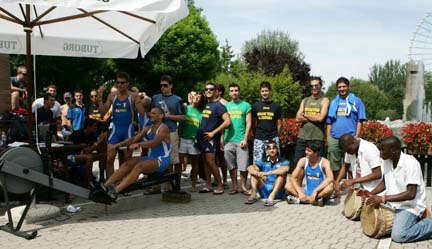|
no. 3 july - september 2007
It costs nothing but is a most precious gift to the young people recovering from addictions at the "Casa del Giovane" in Biella, Italy—the witness of Carmelite community and prayer. Founded in 2005, the monastery is on the campus of a center founded by the charismatic Italian priest, Enzo Boschetti. He had invited the Carmelites to make a foundation in 1985. It took a while for all the pieces to get into place. But the result has been to the benefit of all. Fr. Boschetti founded a series of small homes, in the Piemonte and Lombardia regions of Italy, where young people with addiction problems could live. An essential part of his program was to have a community of contemplative nuns alongside each of these youth homes. Having lived as a Discalced Carmelite for seven years, perhaps it was natural that he would ask the prioress of the Carmelite monastery in Carpineto Romano to assist in his work. Much of the work is part of the mystery of grace. But the sisters and the Casa make it possible to for young people to experience that grace. Some find their way back to the Church after some time at Casa. Four or five wear the Carmelite scapular. The young people are free to participate with the Carmelite community in Vespers. They are required to attend Mass and some eventually become readers or write the Prayers of the Faithful. Sometimes their involvement goes even further. At the Easter Vigil, the young people were in charge of the new fire. They were so conscientious about their assignment that they conducted a test fire at 3PM just to make sure everything would work as planned. "They often move from the idea of coming as an ‘obligation’ to a real desire to participate," said one of the sisters. "Small gestures are so important as this is how they experience the Gospel being lived," volunteers another sister. "Little signs, greetings, offering of your hand to them, a smile. We planted a palm tree as a symbol of the connection and communion between the two communities." It is an interesting mix of people at the monastery’s Mass. There are the five nuns and one postulant. There are people from the area—a factory owner, some young people, the mother of a family, an older woman, and a variety of others. In fact, the chapel is packed on Wednesday and Sunday when the two communities come together. Many times, people in religious ministry feel they are giving to the people but eventually come to realize that they receive much more than they give. The Carmelites have come to realize this. The prioress says "It really is a stimulus for the community to work hard with the prayer. Our community must hold the contemplative life as a high value because it is this prayer which serves them to exit from the tunnel of darkness that these young people find themselves in. Our offering to them is our prayer." The members of the community have also discovered that they need to change their language. One said, "This is a new evangelization! We have to adapt our way of speaking, our vocabulary so that they will understand. We are constantly trying to find more simple ways to speak about faith and the Gospel." While the Carmelites have no direct contact with the young people other than volunteers working on the garden or the outside area of the monastery once a week, the community is firm in their commitment to be a sign of support for the young people who live nearby-- some for up to three years. Apparently the sign value is appreciated. "We find that many of the young people will come back to let us know how they are doing," said one of the sisters. The social workers at Casa del Giovane seem to be getting the message too. There are some non-believers and a Buddhist. The Buddhist returned from an African mission with a statue for the monastery. View of the Carmelite enclosed monastery in Biella, Italy from the Casa del Giovane for young people recovering from addictions. The Carmelite nuns were brought to Biella to give witness to assist the young people through their life and prayer. (CITOC foto)
Rowing from Italy to Columbia for the Kids! The idea was very simple if a bit unusual: get 30 young people to set a Guinness World’s Record and raise the awareness of the sport of rowing and the Carmelite missions in Columbia at the same time. These somewhat divergent goals would both be accomplished by rowing from Italy to Columbia. The amazing part was that there was no beach or ocean and they got the record! Well, maybe they got the record. They are waiting for a response from the people at the Guiness Book of World Records in London who said some decision on the record would be made within the year.
With officially sanctioned stationary rowing equipment in place and cameras to record every moment from various angles, they set out to row as far as possible within a 24 hour period. At the end of that time, the meter showed that they had gone 393,612 meters or 400 km. It was all part of the efforts of Animosa Onlus an organization conceived three years ago in order to build support for the Carmelite missions in Colombia through sports and cultural events. Its name projects the idea of dynamism, a person in movement in order to help their neighbor. Its primary goal is the support of the Maria Eugenia Velandia Educational Center that Italian Carmelite Lauro Negri has headed for over 30 years in Arjona, Colombia. Arjona is on the northern coast of the country and has become a refuge for many who are threatened by the guerillas. Twenty-one year old Davide Riccardi of Forli, Italy is the founder and one of the main proponents of Animosa. He currently serves as the vice-president of the organization. His parents are members of La Familia and are part of the Carmelite community at the Carmelite parish in Forli. (Some of the athletes stayed at the Carmelite monastery during the event.) David spends three weeks during the summer in Arjona and works "on-site" with Fr. Lauro and the people of Arjona.
The Velandia center in Columbia provides education and food for over 400 children as well as provides a safe gathering place for local craftsmen and young people looking to play some sport. If it is possible to set a Guiness World’s Record for rowing from Italy to Columbia without ever leaving land, it is possible for everyone to "row on behalf of the needy". "It is not necessary that everyone be an olympic athlete in order to be supportive of sports," said Davide. "Everyone just needs to have the energy to be at the service of the others." A group of young people who give up their weekend and use their talent as athletes to help people most of them will never meet. They get the gold medal for that. Website of Animosa Onlus: www.animosa.it Davide Riccardi, a members of La Familia, and Carmelite Fredy Marquéz Maza,from Columbia, hold a uniform signed by all the athletes who took part in the Remare Verso la Columbia event to raise the awareness of the Carmelite missions and set a world’s record. Two scenes from the Remare Verso la Columbia event. |
|
RETURN TO THE INDEX FOR 2007 | RETURN TO THE INDEX FOR THIS ISSUE INDEX OF CARMELITE
WEBSITES |



 On
the first three days in September 2006, some of the best Italian athletes
in the sport of rowing gathered at the amusement park in Mirablandia, near
Ravenna. Participating were medal winners from rowing competitions in
various parts of the world, future winners, and at least one World Cup
champion. But none had been involved in something like this before.
On
the first three days in September 2006, some of the best Italian athletes
in the sport of rowing gathered at the amusement park in Mirablandia, near
Ravenna. Participating were medal winners from rowing competitions in
various parts of the world, future winners, and at least one World Cup
champion. But none had been involved in something like this before.  "In
our area of Italy, we are isolated from the world’s poverty," explains
Davide. "We are the priviledged few and we have the responsibility to do
something for those who have less than we do."
"In
our area of Italy, we are isolated from the world’s poverty," explains
Davide. "We are the priviledged few and we have the responsibility to do
something for those who have less than we do."